
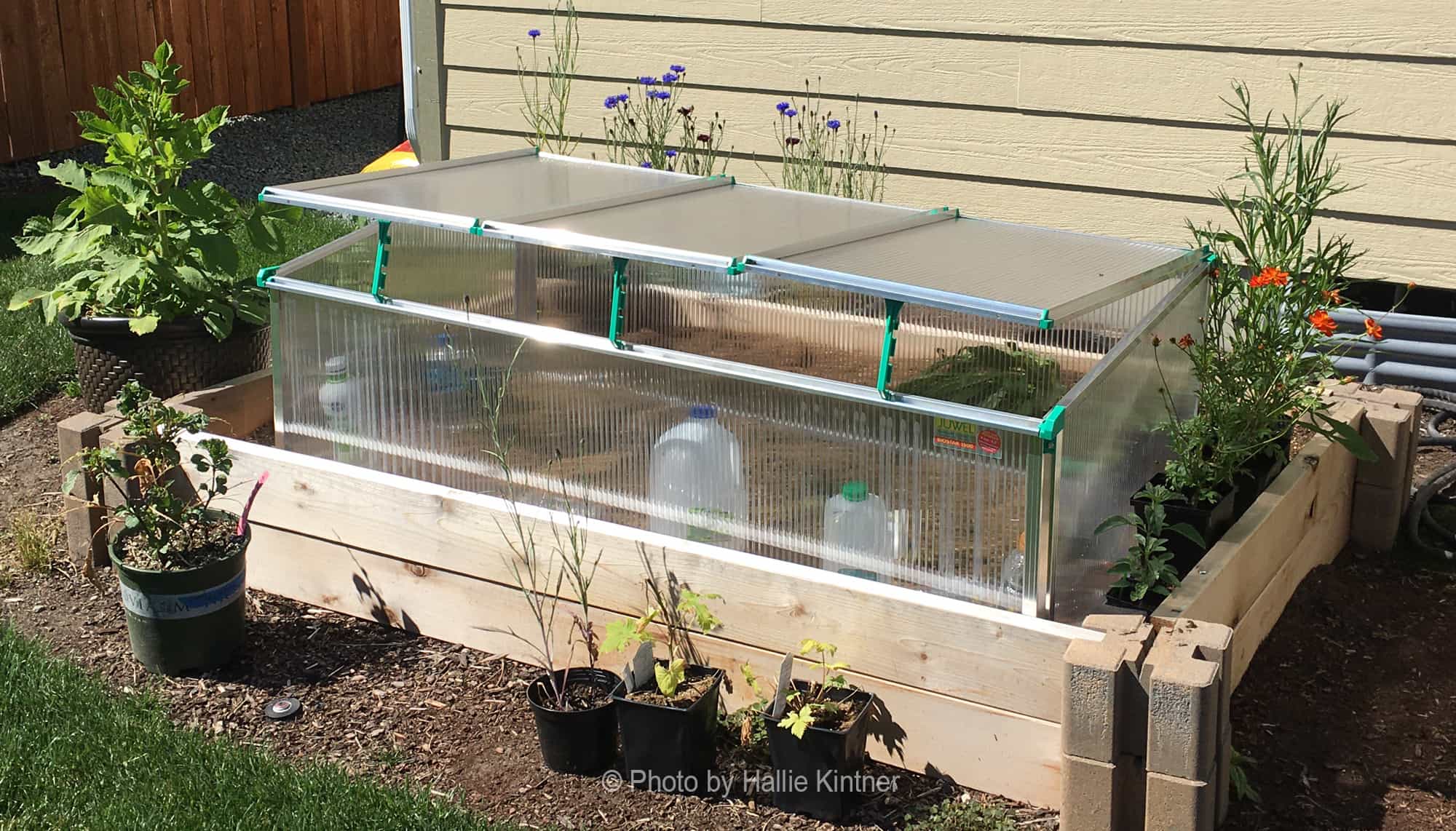
Season Extenders
These practices can extend the growing season by as much as two to four weeks.
Subscribe to the Blog >By Hallie Kintner, Skagit County WSU Extension Master Gardener
Every spring and fall gardeners commiserate over what feels like a short growing season. Our area has between 200 and 230 growing days,1 whereas locations in southwest Washington can have as many as 50 additional growing days. Here in Skagit County gardeners successfully extend the growing season by using what is called season-extending practices. These practices are quite common in colder climates and can lead to larger plant starts in the spring, earlier harvests, and a longer growing season in the fall. Some add to the growing season as much as two to four weeks in both the spring and the fall.2
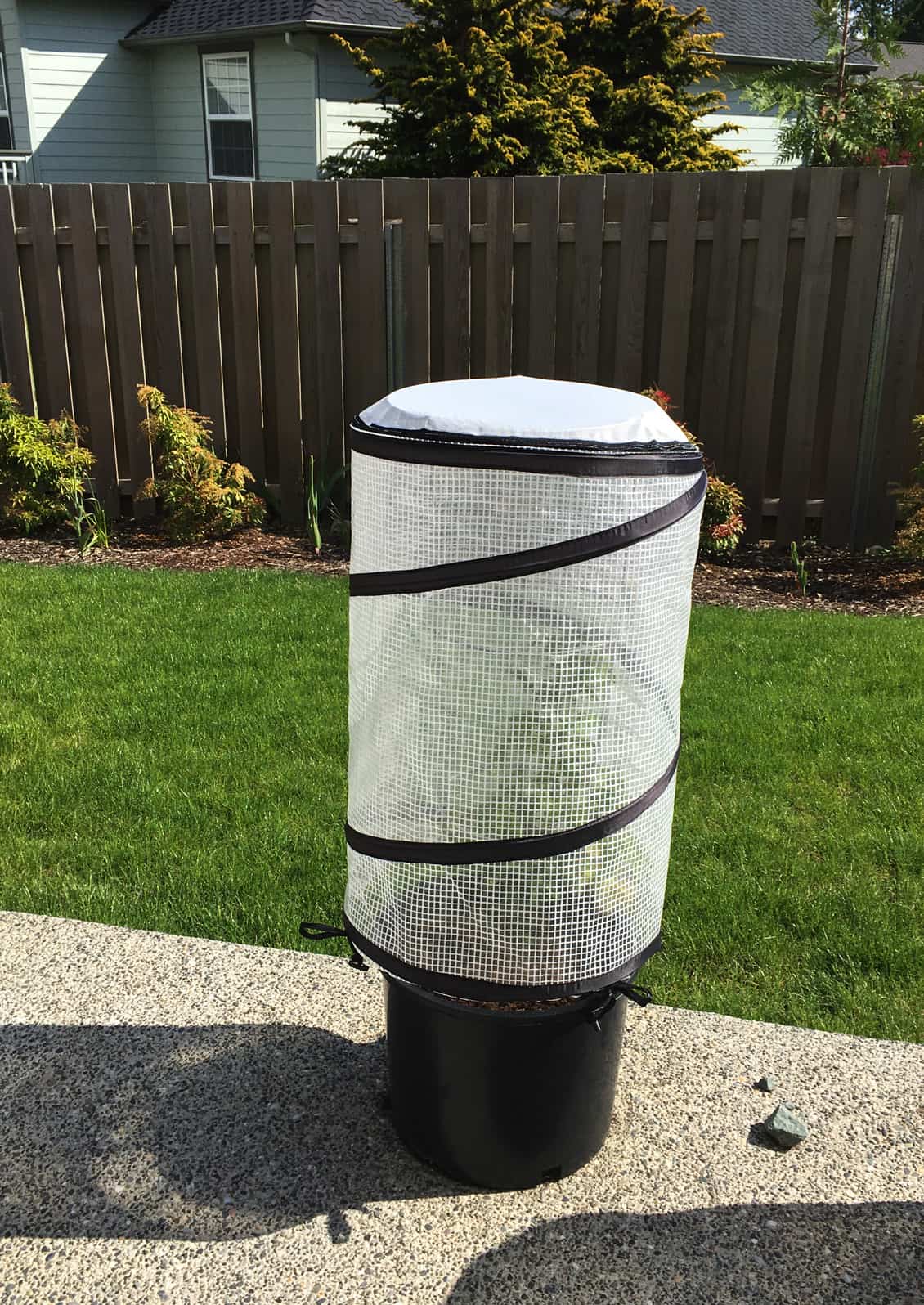
This cover stores flat and pops up to form a cylinder around a container or a plant to keep it warm and protect against the wind. The top mesh unzips for ventilation and rainfall. Photo © Hallie Kintner
Spring and fall weather in our area can see nighttime temperatures drop into the 50° F and even into the 40° F range, making the soil temperatures fall below the optimum for some vegetables and early-season fruits like strawberries. Few plants grow well when temperatures drop below freezing.
To extend the growing season and enjoy the bounty of the garden longer, these are some of the methods Skagit County WSU Extension Master Gardeners use in the Discovery Garden on Hwy 536 west of Mount Vernon.
Raised beds
In addition to the many advantages raised beds provide, they extend the garden season. The soil in raised beds warms earlier in the spring and maintains its warmth later in the fall.
Cold frames
Resembling low-walled raised beds, cold frames are bottomless boxes with clear glass or plastic lids attached by a hinge. The lid can be opened or closed depending on the temperature. Cold frames protect plants from wind, rain, ice, snow, and cool temperatures. The hinged lid is opened on warmer days when it becomes too hot inside for the plants and closed again in the evening. Cold frames also have a long history of being used for starting seeds or hardening off plants before planting in the garden. 3
Cold frames should be placed on well-drained soils with southern exposures. Interior temperatures are warmed by the sun heating the frame and soil. With the addition of an external heating element like electric heating cables, a cold frame can become a hot frame.
Cold frames work especially well for growing cool-season crops like lettuce, radishes, and spinach in the spring. Start cool season vegetables in late summer with the cold frame lid open and then, as summer moves into fall and the nights become cooler, close the lid to retain warmth.
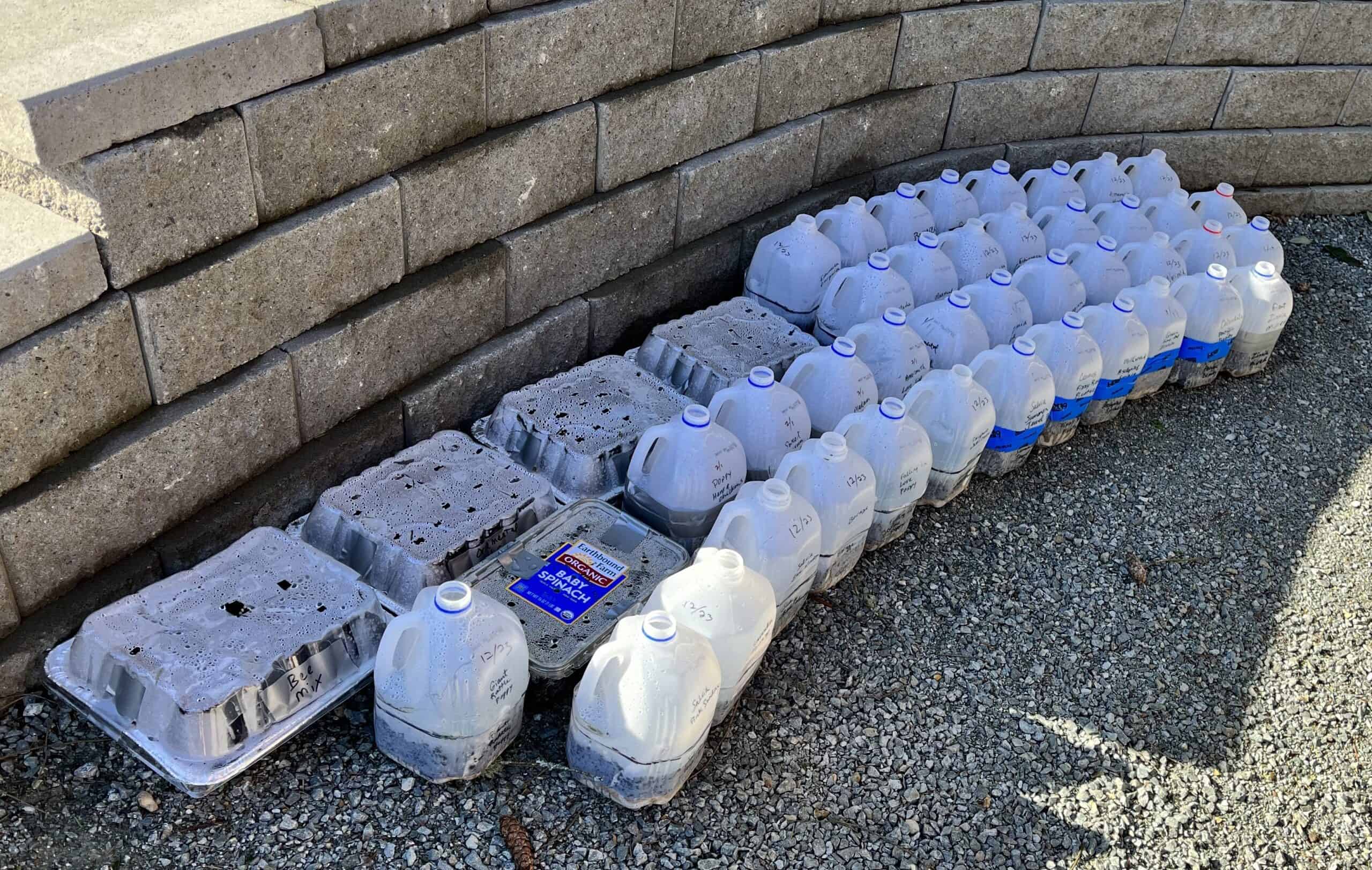
Milk jugs or other plastic containers can be used as miniature greenhouses for starting seeds in winter, getting a jump on spring planting. Our 12/22 blog explains this technique at https://www.skagitmg.org/winter-sowing-technique/
Cloches
These covers act as miniature greenhouses for individual plants. The word “cloche” is a French word meaning a bell-shaped cover. A cloche can be a glass jar or a translucent plastic milk jug, cut in half and placed over an entire plant. As with cold frames, when using a cloche be certain to allow ventilation as the temperature increases. Glass or plastic cloches can protect against wind, weather, and even snails and slugs.
Water-filled tomato protectors are another type of cloche. They are plastic cylinders consisting of water-filled tubes that are placed teepee-style around individual young plants. The protectors act like an igloo to protect heat-loving transplants like tomatoes, peppers, cucumbers, melons, and eggplants early in the season. The sun warms the water in the cells during the day, and the heat is released slowly during the night. The tomato protectors can be removed when the plants grow outside the cylinder and the weather improves. They can protect down to about 16° Fahrenheit. 4
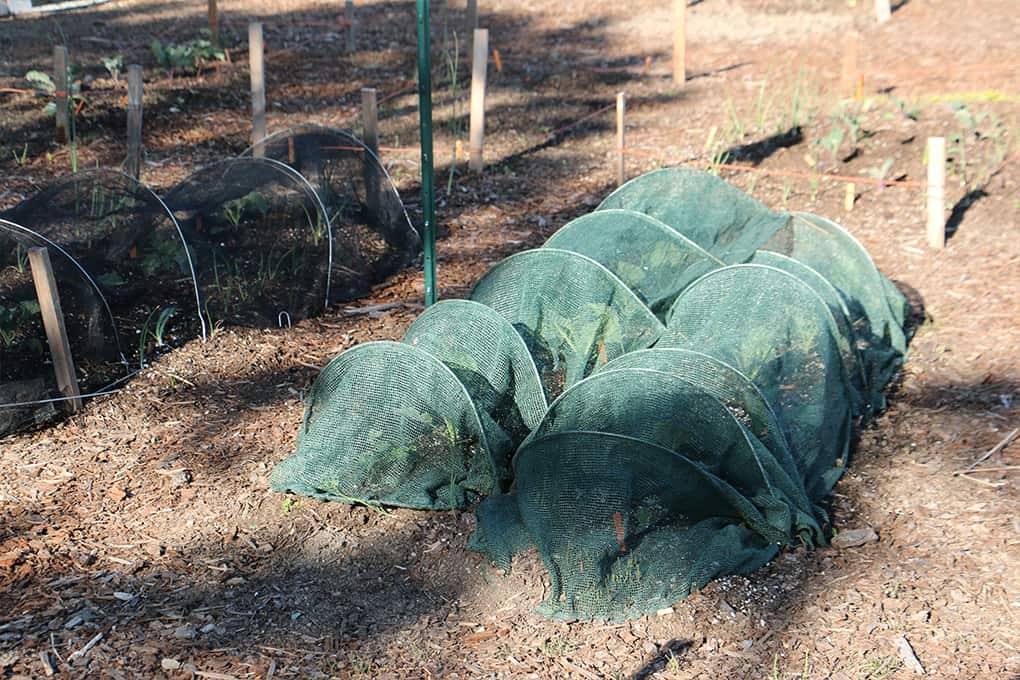
These row covers in the Discovery Garden allow rain to go through them while protecting against cold temperatures and insects. Photo © Kay Torrance
Floating row covers
Row covers are synthetic fabrics placed on top of a plant row or raised bed. They allow rain to go through them while protecting against cold temperatures and insects.5 Unlike the cold frames and cloches, row covers don’t protect against deer and other critters. Use garden staples or soil pins to anchor row covers, keeping them in place during windy conditions.
The synthetic fabrics used for row covers are available in different thicknesses corresponding to varying levels of light transmission and cold insulation. Light-weight row covers transmit 80%-90% of the light but are easily torn and do not protect against frost. Medium-weight row covers protect to 28° Fahrenheit and transmit 85% of available light. Heavy-weight row covers transmit only 35-50% of the light but can protect to 24° Fahrenheit. Heavy-weight covers are best for frost events; remove them after the temperature rises.
If the plants you are growing need pollination by insects, such as cucumbers, squash, and pumpkins, remove the covers after the plants bloom so that the insects can reach the flowers.
Unfortunately, strong winds can blow away floating row covers and damage tender plants. To solve this, many gardeners attach the fabric to temporary arched structures. These supported row covers consist of row cover fabric draped over and attached to bent tubes or rods, forming a hoop tunnel or a ribbed framework. The ends of the row cover are opened to allow ventilation to enter where the fabric is gathered and secured. The tunnel can be opened on warm, sunny days and then closed overnight.
Tunnels can be low, only 2-3 feet tall for a row of low-growing plants like greens or a raised bed.6 Low tunnels are best for low-growing, heat-tolerant plants including strawberries, melons, herbs, certain cucumbers, and greens.
If fungal diseases are an issue, plastic sheeting can be draped over the hoops to replace the row cover fabric. The resulting tunnels protect plants from the rain6 but the plants will require irrigation and will be warmer than the row cover fabric.
Tunnels can also be tall enough for an adult to stand (high tunnels). Many commercial high tunnels are too large for home gardeners because they are meant for the plants to be grown in the ground. 7 High tunnels for home gardeners are often temporary structures constructed of plastic or fabric draped over a metal ribbing and attached to a short, wooden wall as a foundation. Both high and low tunnels are typically unheated and without access to electricity.
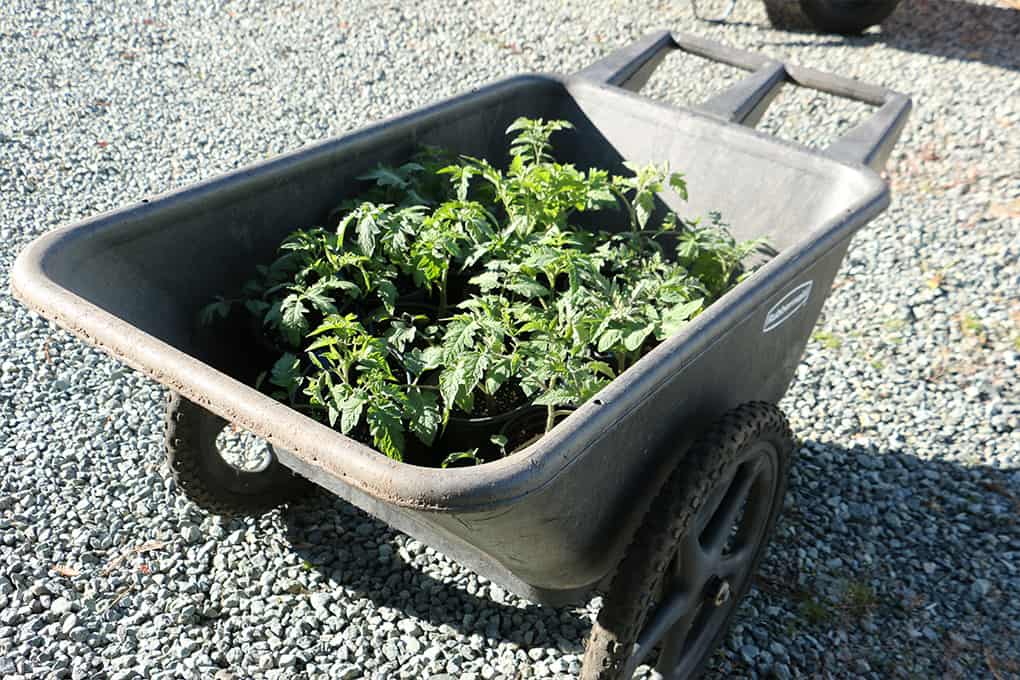
Gardeners often get creative when it comes to protecting early season tomato starts. Collected on a garden cart, these starts enjoy a sunny spring day, and then are easily moved back into the garage in the evening to protect from cooler overnight temperatures.Photo © Kay Torrance
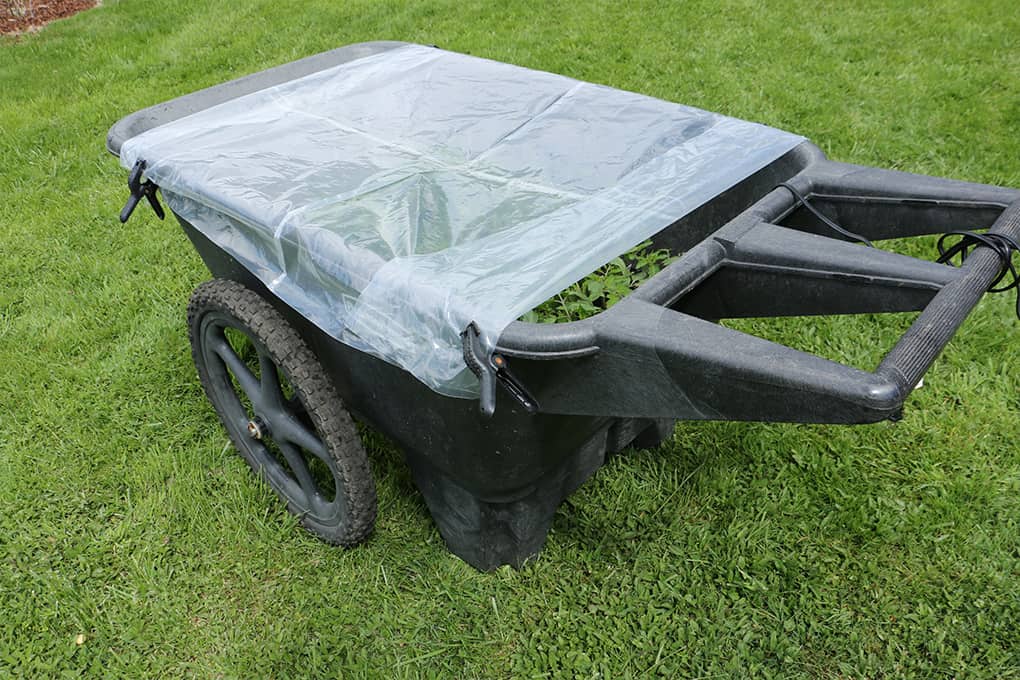
By loosely laying plastic over the garden cart in the evening, some of the heat captured is heat is retained into the evening hours. Photo © Kay Torrance
Greenhouses
The king of season extenders is the greenhouse. These permanent structures consist of glass or plastic panels built into wood or metal frames usually on a foundation. To provide a warm, moist environment, greenhouses need power for ventilation and lights, drainage, and benches along with garden equipment. A greenhouse is a major investment of resources and requires careful planning. 3
The purpose of all-season extenders is to protect plants from the cold weather by trapping heat from the sun, keeping plants and soil warmer as the outside temperatures drop, and protecting them from the elements. Try some of the techniques outlined here and you will reap the benefits from an extended growing season.
REFERENCES:
- McMoran, D. (2015) Skagit County Washington State University Extension Agricultural Statistics. https://extension.wsu.edu/skagit/agriculture/
- Steil, A. (2023) All about cold frames. Iowa State University. https://hortnews.extension.iastate.edu/all-about-cold-frames
- Hamilton, M., Werlin, J., Boone, K., & Austin, G. (2022) An introduction to season extension for high-altitude, short-season gardens. University of Idaho Extension BUL936, September 1, 2022. https://www.uidaho.edu/extension/publications/publication-detail?id=bul0936
- Hodges, L., (2007) Early Season Extension Using Hotcaps. University of Nebraska-Lincoln Extension G1745. https://extensionpublications.unl.edu/assets/pdf/g1745.pdf
- Parker, J., Miles, C., Murray, T., & Snyder, W. (2012) How to install a floating row cover. Washington State University Extension Fact Sheet FS089E, 2012. https://pubs.extension.wsu.edu/how-to-install-a-floating-row-cover-home-garden-series

Hallie Kintner
ABOUT THE AUTHOR:
Hallie Kintner is a Skagit County WSU Extension Master Gardener, Class of 2020. She is a member of the Community Outreach and Education Committee and enjoys working in the vegetable garden at the Discovery Garden on Hwy 536 west of Mount Vernon.
Questions about home gardening or becoming a Master Gardener, may be directed to: Skagit County WSU Extension Office, 11768 Westar Lane, Suite A, Burlington, WA 98233; by phone: 360-428-4270; or via the website: https://extension.wsu.edu/skagit/mg/